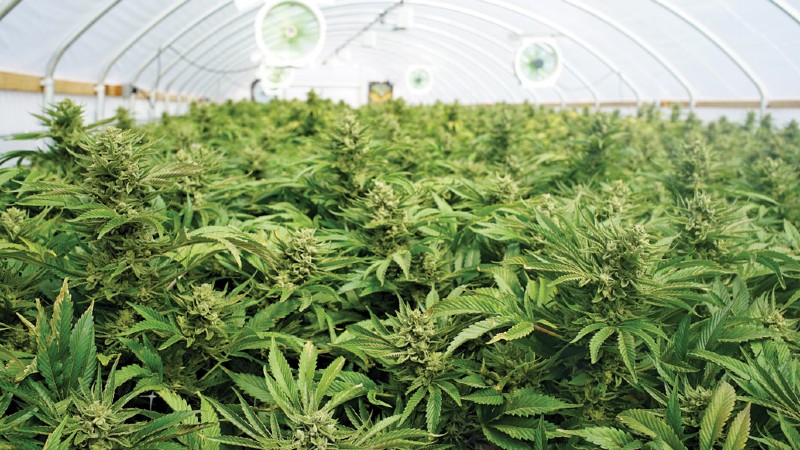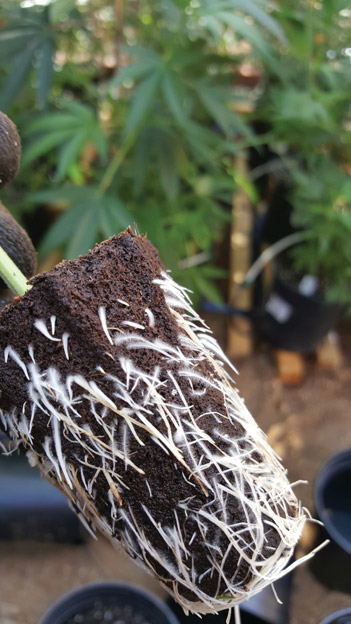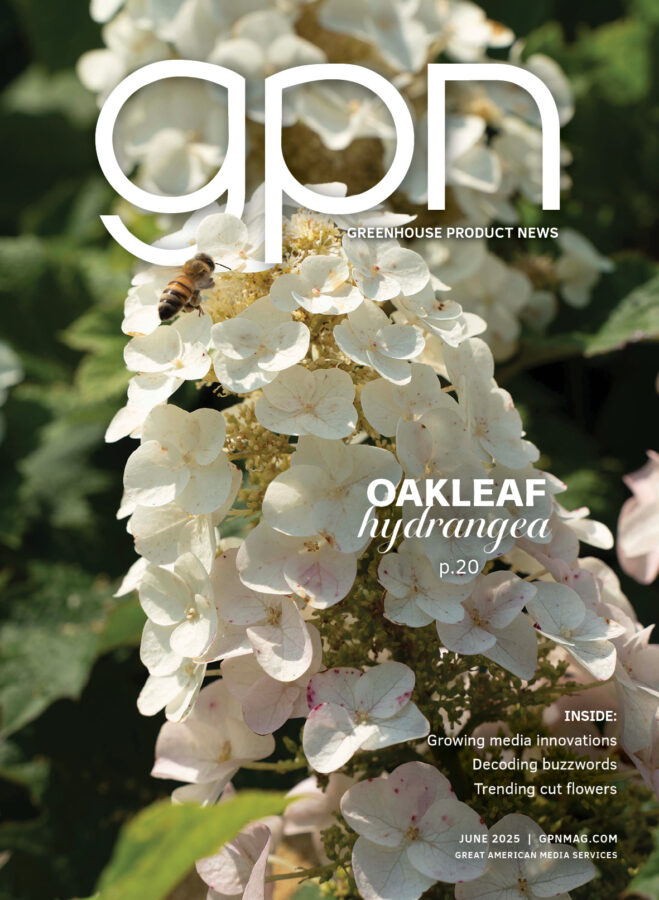
Outstanding Cannabis Flowering Depends on the Roots
Building and maintaining an efficient indoor operation depends on eliminating risks wherever you can, and the growing media you choose is no exception. Sure, a premium mix is crucial for healthy, uniform crops and high yields, but there’s more to it than that. The right approach will help you optimize your space, your labor force and your water usage. The right supplier will go out of their way to provide the solutions and support you need — when you need them. Best of all, you’re taking the guesswork out of the end result. Let’s take a look at the specifics.
THE SECRETS TO PROPAGATION SUCCESS
The first step in the growing process is crucial to achieving optimal results. With the right mix, you’ll obtain a uniformly excellent crop that requires minimal labor interventions. Look for a specialty growing medium that is optimized for cannabis. It should provide the pH level cannabis loves (6.0 to 6.8), as well as precisely balanced micronutrients and macronutrients to stimulate gradual nutrient uptake without stressing the plant.
A carefully calibrated mix of peat moss, with coco peat or wood fiber, plus amendments, has been proven to encourage strong root development — the No. 1 secret to growing thriving, wilt-free plants. It will also allow for excellent drainage and water-holding capacities, resulting in less mold and mildew, while saving on water consumption without any loss of performance. At the same time, its excellent aeration levels stimulate root initiation, formation and growth, while eliminating compaction, root rot, and other issues.
Minimize crop variation by providing each young plant with the same amount of growing media. Filling your propagation trays by hand may seem like a cost savings, but it’s often very inefficient. It can easily result in a difference in the amount of media per tray cell by 20% or more. In turn, this discrepancy leads to deviations in the amount of water and nutrients each plant gets, and ultimately in plant size and time to reach maturity.
A specialty substrate input, such as a pellet or stabilized media plug, makes it easy to ensure each plantlet gets off to the best start because each one will be of consistent weight and composition. This ensures all of your plants get the same nutrition, EC and pH values, as well as those aeration, drainage and water-holding capacities needed for a great outcome. Too much of any one mineral could lead to nutrient burn, characterized by shriveled, brown leaves or nutrient lockout, where growth is stunted.
For additional efficiency, the plug should be easy to store and ready to use. It should be fully compatible with automated systems for rapid handling, while protecting the fragile plantlets, and it should be soft and spongy enough that cuttings can be inserted without damage. Ideally, the plugs will have a generous dibble hole to accommodate any variations in clone size. To summarize, you’ll get the best results during propagation by ensuring your growing media is:
• Of consistent weight and composition;
• Optimized for cannabis;
• Well-draining and with proper aeration; and
• Automation compatible.
RISK-FREE TRANSPLANTATION
When it comes time to transplant your rooted young plants, avoid transplant shock by using a mix that contains exactly the same material as the plug. This will create the ideal conditions for continual, fast development. Placing the plug in a matching grow block (aka coco block) is a fast and effective solution here. Like plant plugs, proprietary grow blocks are ready to use straight off the pallet. You’ll have zero to minimal transplant shock as the root zone does not experience any significant disruption or movement.

You could transplant the young plants straight to a grow bag (coir bag), but splitting the growing process into three phases maximizes your available space by enabling crop scheduling. This is a far more productive approach: clearly, you can grow far more seedlings per square foot than young plants, and more young plants than grown plants. With crop scheduling, you can create a “queue” of young plants ready for finishing off while the previous crop matures.
GETTING READY TO HARVEST
By now, your crop should be thriving. Once the plant is fully established (after about four weeks), it’s time to move it to its final growing environment before harvesting. Once again, it’s important to ensure uninterrupted growth by providing the same growing media as the plant plug and grow block. Ensure the mix is triple washed to save you time and labor.

A premium grow bag delivers the flexibility many cultivators need. Premium grow bags will contain RHP-certified high-quality substrate that has been dried to allow for efficient transportation and storage, and come ready supplied with plant, dripper and drainage holes for two plants. Simply rehydrate the substrate and place the grow blocks in the spaces provided.
An easy fill-type bag is even more convenient. This method eliminates the need to mix substrate or fill pots as the bags come pre-filled and ready to use after one flush. They’re extra deep, allowing the plant’s tap root to flourish. These bags can simply be moved farther apart from each other as the plants grow so that each one gets enough space and light. This also helps to ensure plants don’t touch or overlap, enhancing hygiene. If a plant should become contaminated with a disease or pest, it can easily be isolated from the rest. So, you’ll be harvesting a bumper crop of healthy plants within about 12 weeks.
SUSTAINABILITY MATTERS
Sustainability, biological pest control and reusability are major concerns for many growers. Growing media should be sterile and CEA-optimized. These will minimize contamination risks and facilitate non-chemical control of any insects, molds and diseases that might occur.
Reducing plastic is another area where you can make a real difference to the environment. In the past, plugs, grow blocks and the like were surrounded by netting made of fossil plastics, creating a real problem to dispose of post-harvest. Now, a new generation of those products is available made with polylactic acid (PLA) netting. PLA is based on corn starch, so the netting is 100% biodegradable, eliminating disposability issues. Also, if you’re using grow bags, check if they are recyclable after use.
FIND A RELIABLE PARTNER
As the medical cannabis industry has taken off, so has the number of businesses offering growing media and other supplies. But each grower’s needs are unique and so are the solutions that will work best for them. So be sure to find a reputable supplier who will take the headaches out of your growing media needs.

Find a business with real experience in creating growing media for the cannabis industry, not just for horticulture. A decade or two is not too much to ask. They could become a true partner in your business success, offering technical support during trials and way beyond. Obviously, this is particularly important if you are new to the industry, but even experienced growers might welcome advice from time to time. To have a seasoned expert — not a chatbot — available to answer their questions is a real asset when issues arise.
For cash crops like cannabis, growing media formulations must be stringently controlled. Can your prospective supplier guarantee the composition of each product, batch after batch? How are products kept free of contaminants? Only businesses that control their entire supply chain, from raw materials to shipping, can effectively minimize the risk of contamination. Certification is an excellent way to verify you are using a high-quality product containing the same formulation, year in, year out. Tip: OMRI listed products are organic, ISO 22000 certification means growing media are deemed food safe, and European RHP certification is the gold standard when it comes to substrates — RHP-certified production will adhere to a very tight spec of variance.
Be sure to ask about the size of their operation. Will they be able to deliver the solutions you need, every time? This is especially important to bear in mind for the future, when you’ll need to scale up. Do they have a range of options available, including end-to-end solutions and tailored products? And do they invest in scientific research and testing? The best businesses will offer education on the latest developments in the field and this could give you a real edge over your competitors. Don’t get left behind. As you can imagine, premium solutions are not the cheapest per unit. But they’ll deliver the kind of enhanced performance investors prize. They’ll save you up to a week in rooting time, boost yields and cut losses. They’ll also help reduce labor costs, water consumption and disposability issues. Above all, you’ll have a standout product to take to market, every time.
For an enhanced reading experience, view this article in our digital edition by clicking here.









